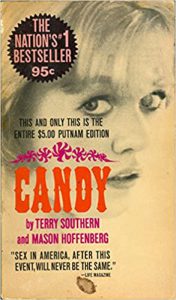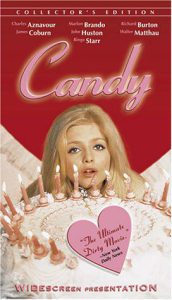Death Smiles on a Murderer (1973) by #JoeDAmato
w/ #KlausKinski #EwaAulin #LucianoRossi
A man discovers an ancient Incan formula for raising the dead, and uses it for a series of revenge murders.#Horror #Giallo#NotQuiteClassicCinema pic.twitter.com/NJwJvnCSQw
— Angus Kohm (@AngusKohm) August 1, 2020
Back in May of 2020, I wrote about my first cinematic encounters with Klaus Kinski. I may or may not have said it then, but whenever I see Klaus Kinski’a name in the credits of a movie, it is always an added incentive for me to watch it. I don’t think I have ever made mention of Ewa Aulin. In fact, I don’t recall ever having heard or seen the name Ewa Aulin prior to watching Death Smiles on a Murderer (1973) last #FridayNightAtTheHomeDriveIn. This may not quite be true, as I have seen at least one of her other performances. She only has eighteen listed on the IMDb, but one of the titles sticks out like no other: Candy (1968).
 I have not seen Candy, but I am very familiar with it. This is mainly because I read the book by Terry Southern (and Mason Hoffenberg). Don’t ask me why, as I had never heard of it or Terry Southern at the time. I think I picked up five paperbacks for dollar in some used bookstore and Candy was one of them. It was amusing, but I can’t say that I particularly loved it.
I have not seen Candy, but I am very familiar with it. This is mainly because I read the book by Terry Southern (and Mason Hoffenberg). Don’t ask me why, as I had never heard of it or Terry Southern at the time. I think I picked up five paperbacks for dollar in some used bookstore and Candy was one of them. It was amusing, but I can’t say that I particularly loved it.
Then a few years later I saw VHS Collector’s Editions of the movie version of Candy and I was surprised that it even existed. I was tempted to buy it, as I have always been a sucker for nice looking Collector’s Editions of movies – even ones that I had never heard of…
 I didn’t buy it, because I recalled not loving the book, and most often when people see movie adaptations of books they say “The book was better.” So if the book was better than this movie, I didn’t think I needed to see it.
I didn’t buy it, because I recalled not loving the book, and most often when people see movie adaptations of books they say “The book was better.” So if the book was better than this movie, I didn’t think I needed to see it.
A few years later, I met a nice old lady in New York who told me that a relative of hers had once produced a terrible movie that had embarrassed his whole family – and it was called Candy. I told her that I knew about Candy and she was amazed.
“I haven’t seen it,” I told her.
“Don’t” she said.
But this is really another story. My point is that I probably saw the name Ewa Aulin on the nice VHS box of Candy, but if I did, I don’t remember.
Incidentally, Terry Southern was a successful writer who, among other things, co-wrote Easy Rider (1969) with Dennis Hopper and Peter Fonda (which is a favourite of mine) and The Cincinnati Kid (1965) which is a very good movie. So, he was clearly a good writer. And I don’t mean to suggest that Candy was a bad book. It was very popular and I’m sure some people loved it. Somehow it just didn’t speak to me.
Oddly enough, many years later I was writing a play for a major Canadian theatre, and they put me together with a dramaturge who they thought could help me “shape my play into something that would work in their theatre”. The dramaturge read my latest draft and said:
“This seems to be a picaresque story.”
“A what?” I said.
He went on to explain, in his own words, what that was. I can’t recall exactly what he said, but Dictionary.com defines it as “an episodic style of fiction dealing with the adventures of a rough and dishonest but appealing hero.”
This did describe my play quite well, actually.
The dramaturge went on to mention that the French novel Candide by Voltaire, was an example. As he talked about the book, it slowly dawned on me that Candy was a version of Candide.
I’ll be damned, I thought. Maybe there was more to that book than I had realized. Maybe I needed to read it again…
I never have. But I do want to see the movie – especially now that I’ve seen Ewa Aulin in Death Smiles on a Murderer.
Death Smiles on a Murderer was directed by Joe D’Amato, who had primarily been a director of photography early in his career. He started directing movies under assumed names, because he didn’t want to jeopardize his reputation as a cinematographer. He started with spaghetti westerns, then did some comedies – always under other names. The first horror film he made was Death Smiles on a Murderer – and he used his real name, Aristide Massaccesi! For some reason he continued to make horror films but under the name Joe D’Amato. D’Amato became known for gore films like Beyond the Darkness (1979) and Antropophagus (1980), as well as erotic films like Emanuelle in America (1977) and Erotic Nights of the Living Dead (1980), which obviously crossed over with horror.
In fact, D’Amato made over a hundred hard core erotic films as well. He has a total of 196 directing credits on the IMDb. Quite remarkable. I’ve seen a number of his films, but I’ve hardly scratched the surface of his total output. I was excited to finally get a chance to see his first horror film, Death Smiles on a Murderer last week, and it didn’t disappoint me.
I had been expecting it to be a giallo, and it does have some very giallo-like moments, but it is more of a gothic horror story at heart. It’s also got a very unpredictable plot, with a few unusual twists and turns. It’s hard to say exactly what it is, and yet somehow it works.
The atmosphere and the cinematography are top notch, and the film features several nods to Edgar Allan Poe, which are always welcome.
I don’t want to say too much more about it, because I believe it’s better to go in not knowing what to expect. If you’re a fan of Joe D’Amato, Klaus Kinski, horror films, giallos, Ewa Aulin, or movies that are hard to categorize, give this one a shot. It’s a certified #NotQuiteClassicCinema classic.
